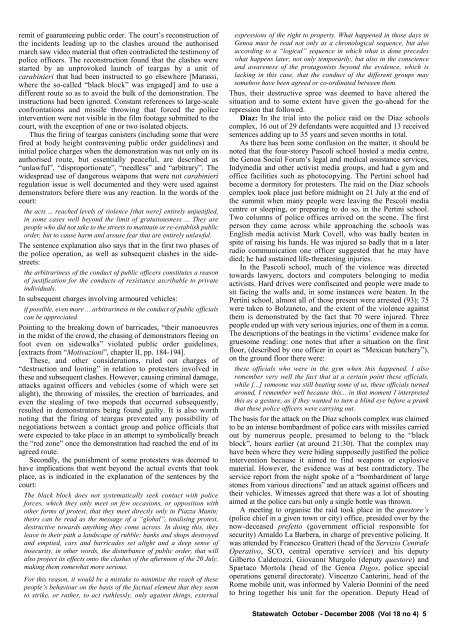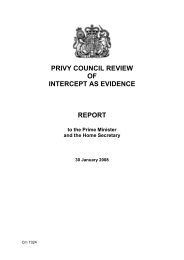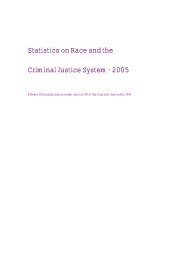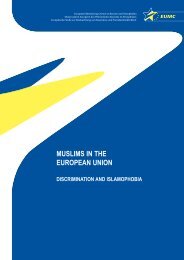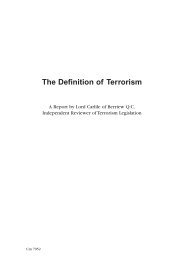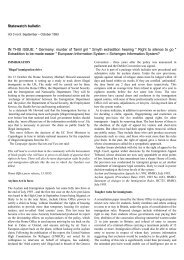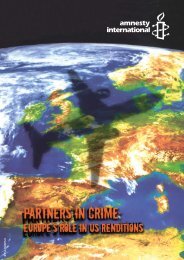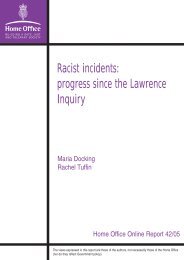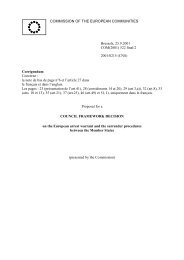Vol 18 no 4 - Statewatch
Vol 18 no 4 - Statewatch
Vol 18 no 4 - Statewatch
Create successful ePaper yourself
Turn your PDF publications into a flip-book with our unique Google optimized e-Paper software.
emit of guaranteeing public order. The court’s reconstruction of<br />
the incidents leading up to the clashes around the authorised<br />
march saw video material that often contradicted the testimony of<br />
police officers. The reconstruction found that the clashes were<br />
started by an unprovoked launch of teargas by a unit of<br />
carabinieri that had been instructed to go elsewhere [Marassi,<br />
where the so-called “black block” was engaged] and to use a<br />
different route so as to avoid the bulk of the demonstration. The<br />
instructions had been ig<strong>no</strong>red. Constant references to large-scale<br />
confrontations and missile throwing that forced the police<br />
intervention were <strong>no</strong>t visible in the film footage submitted to the<br />
court, with the exception of one or two isolated objects.<br />
Thus the firing of teargas canisters (including some that were<br />
fired at body height contravening public order guidelines) and<br />
initial police charges when the demonstration was <strong>no</strong>t only on its<br />
authorised route, but essentially peaceful, are described as<br />
“unlawful”, “disproportionate”, “needless” and “arbitrary”. The<br />
widespread use of dangerous weapons that were <strong>no</strong>t carabinieri<br />
regulation issue is well documented and they were used against<br />
demonstrators before there was any reaction. In the words of the<br />
court:<br />
the acts ... reached levels of violence [that were] entirely unjustified,<br />
in some cases well beyond the limit of gratuitousness ... They are<br />
people who did <strong>no</strong>t take to the streets to maintain or re-establish public<br />
order, but to cause harm and arouse fear that are entirely unlawful.<br />
The sentence explanation also says that in the first two phases of<br />
the police operation, as well as subsequent clashes in the sidestreets:<br />
the arbitrariness of the conduct of public officers constitutes a reason<br />
of justification for the conducts of resistance ascribable to private<br />
individuals.<br />
In subsequent charges involving armoured vehicles:<br />
if possible, even more ... arbitrariness in the conduct of public officials<br />
can be appreciated.<br />
Pointing to the breaking down of barricades, “their ma<strong>no</strong>euvres<br />
in the midst of the crowd, the chasing of demonstrators fleeing on<br />
foot even on sidewalks” violated public order guidelines,<br />
[extracts from “Motivazioni”, chapter II, pp. <strong>18</strong>4-194].<br />
These, and other considerations, ruled out charges of<br />
“destruction and looting” in relation to protesters involved in<br />
these and subsequent clashes. However, causing criminal damage,<br />
attacks against officers and vehicles (some of which were set<br />
alight), the throwing of missiles, the erection of barricades, and<br />
even the stealing of two mopeds that occurred subsequently,<br />
resulted in demonstrators being found guilty. It is also worth<br />
<strong>no</strong>ting that the firing of teargas prevented any possibility of<br />
negotiations between a contact group and police officials that<br />
were expected to take place in an attempt to symbolically breach<br />
the “red zone” once the demonstration had reached the end of its<br />
agreed route.<br />
Secondly, the punishment of some protesters was deemed to<br />
have implications that went beyond the actual events that took<br />
place, as is indicated in the explanation of the sentences by the<br />
court:<br />
The black block does <strong>no</strong>t systematically seek contact with police<br />
forces, which they only meet on few occasions, or opposition with<br />
other forms of protest, that they meet directly only in Piazza Manin;<br />
theirs can be read as the message of a “global”, totalising protest,<br />
destructive towards anything they come across. In doing this, they<br />
leave in their path a landscape of rubble: banks and shops destroyed<br />
and emptied, cars and barricades set alight and a deep sense of<br />
insecurity, in other words, the disturbance of public order, that will<br />
also project its effects onto the clashes of the after<strong>no</strong>on of the 20 July,<br />
making them somewhat more serious.<br />
For this reason, it would be a mistake to minimise the reach of these<br />
people’s behaviour on the basis of the factual element that they seem<br />
to strike, or rather, to act ruthlessly, only against things, external<br />
expressions of the right to property. What happened in those days in<br />
Ge<strong>no</strong>a must be read <strong>no</strong>t only as a chro<strong>no</strong>logical sequence, but also<br />
according to a “logical” sequence in which what is done precedes<br />
what happens later, <strong>no</strong>t only temporarily, but also in the conscience<br />
and awareness of the protagonists beyond the evidence, which is<br />
lacking in this case, that the conduct of the different groups may<br />
somehow have been agreed or co-ordinated between them.<br />
Thus, their destructive spree was deemed to have altered the<br />
situation and to some extent have given the go-ahead for the<br />
repression that followed.<br />
Diaz: In the trial into the police raid on the Diaz schools<br />
complex, 16 out of 29 defendants were acquitted and 13 received<br />
sentences adding up to 35 years and seven months in total.<br />
As there has been some confusion on the matter, it should be<br />
<strong>no</strong>ted that the four-storey Pascoli school hosted a media centre,<br />
the Ge<strong>no</strong>a Social Forum’s legal and medical assistance services,<br />
Indymedia and other activist media groups, and had a gym and<br />
office facilities such as photocopying. The Pertini school had<br />
become a dormitory for protesters. The raid on the Diaz schools<br />
complex took place just before midnight on 21 July at the end of<br />
the summit when many people were leaving the Pescoli media<br />
centre or sleeping, or preparing to do so, in the Pertini school.<br />
Two columns of police offices arrived on the scene. The first<br />
person they came across while approaching the schools was<br />
English media activist Mark Covell, who was badly beaten in<br />
spite of raising his hands. He was injured so badly that in a later<br />
radio communication one officer suggested that he may have<br />
died; he had sustained life-threatening injuries.<br />
In the Pascoli school, much of the violence was directed<br />
towards lawyers, doctors and computers belonging to media<br />
activists. Hard drives were confiscated and people were made to<br />
sit facing the walls and, in some instances were beaten. In the<br />
Pertini school, almost all of those present were arrested (93); 75<br />
were taken to Bolzaneto, and the extent of the violence against<br />
them is demonstrated by the fact that 70 were injured. Three<br />
people ended up with very serious injuries, one of them in a coma.<br />
The descriptions of the beatings in the victims’ evidence make for<br />
gruesome reading: one <strong>no</strong>tes that after a situation on the first<br />
floor, (described by one officer in court as “Mexican butchery”),<br />
on the ground floor there were:<br />
these officials who were in the gym when this happened. I also<br />
remember very well the fact that at a certain point these officials,<br />
while [...] someone was still beating some of us, these officials turned<br />
around, I remember well because this... in that moment I interpreted<br />
this as a gesture, as if they wanted to turn a blind eye before a prank<br />
that these police officers were carrying out.<br />
The basis for the attack on the Diaz schools complex was claimed<br />
to be an intense bombardment of police cars with missiles carried<br />
out by numerous people, presumed to belong to the “black<br />
block”, hours earlier (at around 21:30). That the complex may<br />
have been where they were hiding supposedly justified the police<br />
intervention because it aimed to find weapons or explosive<br />
material. However, the evidence was at best contradictory. The<br />
service report from the night spoke of a “bombardment of large<br />
stones from various directions” and an attack against officers and<br />
their vehicles. Witnesses agreed that there was a lot of shouting<br />
aimed at the police cars but only a single bottle was thrown.<br />
A meeting to organise the raid took place in the questore’s<br />
(police chief in a given town or city) office, presided over by the<br />
<strong>no</strong>w-deceased prefetto (government official responsible for<br />
security) Arnaldo La Barbera, in charge of preventive policing. It<br />
was attended by Francesco Gratteri (head of the Servizio Centrale<br />
Operativo, SCO, central operative service) and his deputy<br />
Gilberto Calderozzi, Giovanni Murgolo (deputy questore) and<br />
Spartaco Mortola (head of the Ge<strong>no</strong>a Digos, police special<br />
operations general directorate). Vincenzo Canterini, head of the<br />
Rome mobile unit, was informed by Valerio Donnini of the need<br />
to bring together his unit for the operation. Deputy Head of<br />
<strong>Statewatch</strong> October - December 2008 (<strong>Vol</strong> <strong>18</strong> <strong>no</strong> 4) 5


